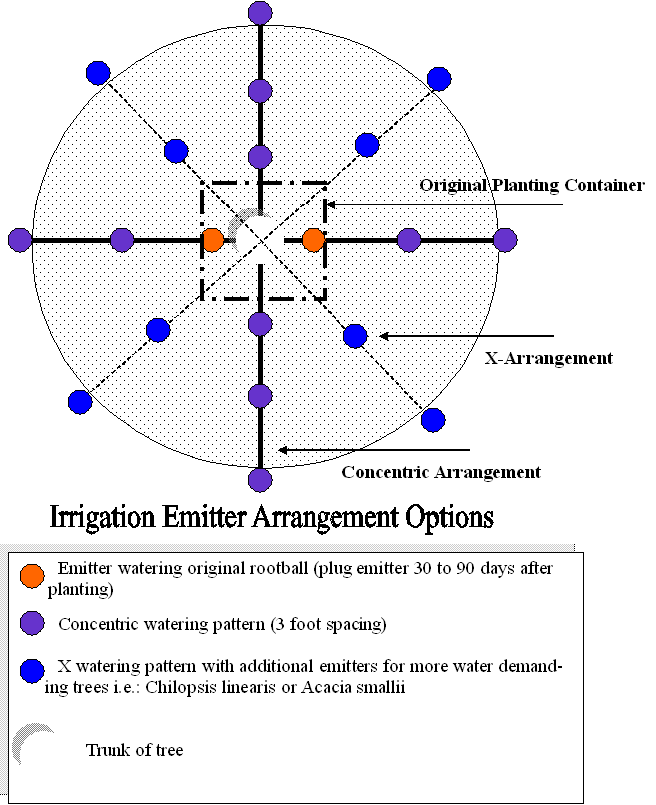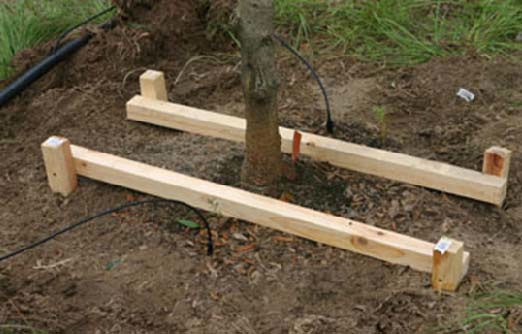


Tree Root Establishment in the Landscape
Trees enhance our awareness of the surrounding landscape and provide us with a touchstone to nature. They soften and accent architectural detail while anchoring and sheltering understory plantings and hardscapes. Landscape architects incorporate trees into their designs with the intention that these trees will thrive for decades, providing shade, color, texture and improve the urban quality of life.
Considering the crucial, central role played by trees in the landscape, the success of a design is as heavily influenced by the emphasis placed on the long term horticultural development of the trees as on the actual specie(s) specified. Roots and rooting are vital for healthy, vigorous tree growth and development. Roots are responsible for the absorption and flow of water and minerals into and through the tree, the storage of energy and anchorage into the native soil. Unfortunately, it is not easy to evaluate root structure and health like you would the branching structure and canopy of a tree. This very important evaluation is difficult to make and often overlooked.
Root systems, and their development, vary from one tree species to another. Various root systems consist of anchoring, feeder, tap, horizontal, sinker and lateral roots. Differing soil profiles, age, maintenance practices and genetic diversity among tree species fosters this assortment of roots that support the trees development and vitality in the landscape. Native soil serves to anchor, provide water, nutrients and oxygen to the tree and developing roots. On construction sites, soil profiles are disturbed or modified as a result of grade change, excavation, trenching, soil compaction, paving, landscaping and irrigation. These changes can have both positive and negative effects on existing and new tree root development. Having an understanding of the existing soil conditions will aid in creating a planting and growing environment that is conducive to successful root development. These soil factors include texture (ratio of sand, clay, and silt), structure (porosity for air and water), fertility, moisture holding capacity and presence of any impenetrable layers. Most tree roots are found at a depth of 2 to 3 feet in the soil profile, depending on irrigation patterns, frequency and duration. Trees growing in heavy clay, non-porous or water saturated soils will produce roots closer to the surface of the soil.
Good root distribution equates to tree stability. Well stabilized trees develop radial roots extending outward and downward from the crown or root flare. Trees propagated/grown in containers need repeated, careful root management when transplanted from one size container to the next and when installed in the landscape. Like tree branches, roots re-branch numerous times. In the nursery, untreated sapling and seedling trees can quickly develop serious, potentially fatal root defects that compromise the ultimate viability of trees after they are installed in the landscape. Simply pruning away ¼”to ½” of the outer edge of the rootball, removing any matted, kinked, and circling roots, corrects many developing root defects and directs root growth outward into the next container size or into the surrounding native soil.
Basic tips for a well developed root system
Purchase trees from reliable suppliers who follow sound root management practices from propagation liner to sellable container sizes. Trees with well disbursed root systems thrive better under all environmental conditions (wind, drought, poor soil conditions), both during and once established. Poor, inadequate, or compromised root systems slow or prevent establishment and contribute to tree failure (wind throw) or deaths (root binding) years after planting.
Fracturing the soil beyond the planting hole increases soil oxygen, water infiltration and allows quicker penetration of new supporting roots into the surrounding native soil. Evaluate the soil profile for texture, structure, fertility, moisture holding capacity and the presence of impenetrable layers. This evaluation will assist in developing irrigation and fertilization schedules. Once the tree is positioned in the planting hole, root prune the rootball (see above) before backfilling. Where possible, avoid staking or guying the tree. If you must stake or guy the tree, remove the stakes or guys as soon as possible. Staking/ guying inhibit the root development, trunk taper and caliper growth of a tree. A new method for stabilizing trees can be seen at http://hort.ifas.ufl.edu/woody/staking.shtml. (See Insert 1)
Irrigation systems must be flexible enough to meet the immediate water needs of a freshly transplanted tree and as it matures. As trees grow the irrigation system must expand to deliver water over a larger area of soil beneath the tree. Limiting the number of immovable emitters produces a physically restricted root system and tends to keep the soil nearest the trunk saturated during and immediately following irrigations.These two conditions can make trees more prone to wind throw.
Extending the irrigation system beyond the original rootball should begin at installation and be monitored through establishment and maturity. One Alternative irrigation design is to install concentric rings (see diagram 1) of emitters that extend out to the drip line of the tree.Such an arrangement would distribute water over a much larger area and result in a more highly dispersed root system. A second alternative would be to arrange 13 emitters in an X pattern (Diagram 1) rather than the rings. In either configuration, the emitter(s) nearest the trunk acts to help settle, compact and firm the soil around the freshly transplanted root-ball. Shortly after transplanting these emitters should be closed or capped and those near the drip line should remain open. The capping of these emitters allows the soil nearest the trunk to dry out and firm up, helping to avoid wind throw. The emitters watering the soil profile near and beyond the drip line will be irrigating the newly developing feeder and anchoring roots. This management approach encourages greater root distribution, a larger total root mass, and a healthier root system that is physically proportional to the trees above ground trunk, branch and foliage mass.


Anchoring a tree without affecting trunk
Two untreated 2x2s are clearly visible on top of the root ball. These are secured with screws to four vertical 4' long 2x2s installed vertically against the root ball. This system eliminates the need to return to the tree to remove wires or other securing straps from the trunk. 2x4s can be used for large trees.
"Illustrations, PowerPoints or photos by Edward F. Gilman, Professor,
Environmental Horticulture Department, IFAS, University of Florida."
http://hort.ifas.ufl.edu/woody/normstake.shtml

© Copyright 2000-2020 Arid Zone Trees